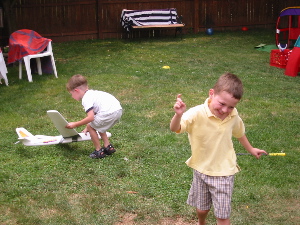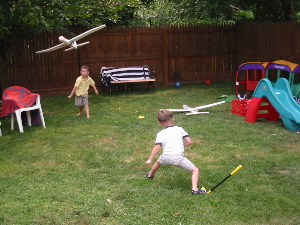Terry just taught me clean washing greenwashing, which is when a company smears on the energy-efficient PR while continuing their old inefficient ways.
And now there’s hygrid, a hybrid of electricity from the grid and rolling your own.
Terry just taught me clean washing greenwashing, which is when a company smears on the energy-efficient PR while continuing their old inefficient ways.
And now there’s hygrid, a hybrid of electricity from the grid and rolling your own.

I recently had a good conversation with Sara Beckman of Berkeley’s Haas School of Business. Comparing what MBA students do in relation to designers, it’s hard to identify what skills they’re missing — other than hard skills like illustration — that designers have. What business students learn in courses like product development is surprisingly similar to product development that designers learn. Sara’s students even do ethnographic studies and build personas.
And in my experience, it’s easier for business people to make the leap into business design activities than designers. Maybe it’s because business is a broader base of training, or because it doesn’t focus on the design of artifacts.
But, business people sometimes have deficiencies in two areas: empathy and abductive thinking. Some designers also lack empathy, unfortunately. But designers can’t get far without the ability to create new ideas. I think designers (and other creative people) are good at generating ideas because they’re allowed to be silly (not because they have a monopoly on the right side of the brain). Silliness leads to new ideas, whether the goal is silly ideas or just new ideas. It’s hard for business people to be simultaneously silly and fiscally responsible; we traditionally view these qualities in opposition. This is a fundamental challenge in business design: how to help clients perceive the potential benefits when they’re used to looking for business rigor or creativity, not both together?

In design language, silliness is often termed play. In Managing as Designing Boland and Collopy describe play:
An open, liquid design process involves playing with ideas, alternatives, and elements of the design. The design emerges through playful interaction with materials, models, and alternatives being considered. Playing with meanings, implications, and purposes of a design project can lead to emergence of unexpected insights or discoveries that can be opportunistically included in the project.
Augusto Grillo writes,
It is play that sparks creativity, creating contexts in which freedom, gratuitousness and passion produce their fecundating action.
Play fascinates and absorbs to the point of making us infinitely repeat our attempts to improve our performance, to create new paths, new ways to arrive, in our case, to the ‘right’ product, the most suitable solutions.
It is in this sense that play can enrich the design process, and that the concept of playfulness in design may justify more exhaustive study in this research area.
We may conclude that ‘play’, so necessary in that it precedes and gives rise to the creative act, like beauty, will save the world.
When Grillo says play compels us to “infinitely repeat our attempts to improve our performance” I’m reminded of the instructional power of play.
Martin is co-founder of Kickstart (formerly Approtec), an organization designing products for the bottom of the pyramid. As opposed to C.K. Prahalad who tends to describe the poor as consumers (see sachet marketing), Martin views the poor as investors. I met him at the ID Design Strategy conference this past week where he told me, “everyone has the same basic need: a way to make money.” So Kickstart researches what the poor in Africa need to make money. Because subsistence farming is common, Kickstart designed a pump that allows farmers to irrigate crops using nearby streams or wells, dramatically increasing crop output and helping the poor enter the middle class. They’ve created other products to help the poor create bricks, hay bales, cooking oil, and so on. By designing inexpensive products and selling them, it ensures the technology finds its way into the hands of people who will use it, a model sustainable beyond charity.
If design is our attempt to ‘change existing situations into preferred ones‘ then Martin was the best designer at the conference.
I’m hesitant to offer a definition of design thinking because there’s probably no one definition everyone could agree on, as with design and its many sub-genres. But after hearing more and more people having trouble referencing it I figured a half-baked blog post couldn’t hurt. I’m reminded of how Lao Tzu said “The tao that can be told is not the eternal Tao” yet still managed to write a book about it.
Design thinking is…
I’m sure one could play with the language and categorization to find more or less characteristics, but I’m happy with just those six.
I finally met the lovely and vivacious Niti Bhan at the ID Design Strategy conference. She gave me one of her hilarious business cards and I discovered she has a blog, check it out.
Stephen Johnson’s new book, Everything Bad is Good for You is getting warm reviews, particularly from Malcolm Gladwell in the New Yorker. Listening to him tonight, I particularly liked his comparison of video game levels to the concept of flow (though he didn’t use that term). Games progressively get harder, so we’re always challenged just beyond the point of our abilities, a brilliant way to structure an educational experience.
Even my tiny Manhattan food market now sports two different brands of recycled paper products.
Annie’s has grown from one product (organic macaroni and cheese) to 80, fueling a $34 million company. The Organic Trade Association estimates the $12.25 billion organic food market will double by 2008, assuming an 18.4% annual growth rate (WSJ, March 29, 2005). With a $20 million investment from Solera Capital, Annie’s (and others on the same growth curve) can expand exponentially.

A recent edition of Extreme Makeover: Home Edition focused on the use of sustainable building products, hybrid cars, and efficient appliances.

Nike’s Considered line eliminates waste & toxics, uses less energy to produce, and reduces waste at the end of the product’s life.

LOS ANGELES, Calif. – February 18, 2005 – Joining the ranks of celebrities choosing to bring an environmental conscience to the Oscars, Leonardo DiCaprio, Charlize Theron, Robin Williams, Orlando Bloom, Salma Hayek, Penelope Cruz, Morgan Freeman and Tim Robbins are among those arriving at the 2005 Academy Awards in high-mileage, low emission, Prius hybrids as part of Global Green’s 3rd annual “Red Carpet—Green Stars†campaign.

GE pledges to invest billions in being green:
“Ecomagination is GE’s commitment to address challenges such as the need for cleaner, more efficient sources of energy, reduced emissions and abundant sources of clean water,” Immelt said. “And we plan to make money doing it. Increasingly for business, ‘green’ is green.”

NYC school kids learn ballroom dancing, wonderful.

Google has acquired Dodgeball, a neato mobile social networking app. It was co-founded and developed by my friend and former mentee Alex, so I’m thrilled for him. Congratulations Alex!
I knew scented candles are incredibly popular because I have trouble finding the unscented variety, but it turns out scented pencils are also quite popular, based on some sales data I’ve seen.
I wonder if the flower trade is worried?